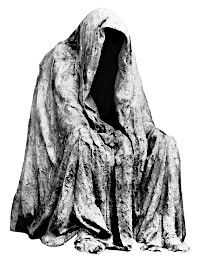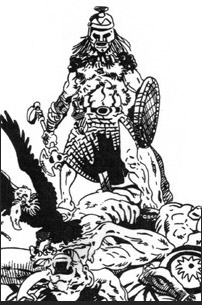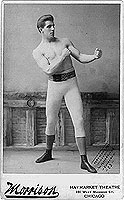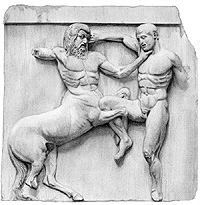I just experienced that chill; the thrilling—no haunting—sensation that travels up my spine to the base of my swiveling ape’s brain when a story clicks. A story clicks for me when I know I am no longer on the hunt for its heart; the feeling I am trying to express, at first mechanically through the plot, then organically through the eyes of the protagonists.
For a short story or novelette this feeling is really the extent of the creation, the writing simply being the execution of that feeling. But for a novel, particularly an epic length one or a volume in an ongoing series, with a large cast of protagonists, the story’s heart can become elusive. Also, in the case of The Sunset Saga at least one new viewpoint character is introduced in every novel.
In writing viewpoint fiction, particularly speculative fiction where the characters are largely ignorant of the plot, it is imperative that the writer be able to mentally ‘get inside of’ each protagonist. This can be difficult when I am writing against type. If all I wrote was fiction from the point-of-view of an eccentric literary minded knucklehead I could do a novel every month of the year! The difficulty lies in cultivating that alien perspective I discussed in The Chronological Alien.
For The Sunset Saga I do employ a formula that goes like this.
I write the dramatic personae list and table of contents with assigned personae.
I then write the lead action character. This character will commit plot-driving acts. Action oriented characters are very easy for me to write.
The next character I write will usually be Three-Rivers as he is introspective, with a perspective long ago internalized by the author. This character puts the plot elements in context.
Next I write the supporting protagonists according to how I am feeling at the time. This can get messy. In writing God’s Picture Maker I found myself see-sawing back and forth between pacifist Navaho widow, Hyacinth White Feather, and Bruco, a pitiless blaspheming stone-age man torn from his native land and raised by the most ruthless conquistadors as a human blood hound. I cannot write them both on the same day! I wrote Hyacinth in unplanned bursts just after seeing beautiful natural phenomena—not an everyday occurrence in Baltimore. I was more easily inspired to write Bruco in response to negative ghetto stimuli.
The last thing I do before starting from the top and rewriting the whole thing with an eye towards consistency is write the new character[s], in this case Leonardo. An artist is a stretch for me. Doing Burton took time and research but was not against type for me psychologically. After reading everything I could on Leonardo I was still left shifting in the winds of my imagination wondering how to connect with a genius with a mania for visual art and a suppressed yearning for handsome young men. How does a kinetic man write an aesthetic man?
For an answer I looked into my past to the inspiration for The Sunset Saga, into the searching watery eyes of the boy who was the inspiration for Doctor Charlie Robinson; the quixotic quantum physicist that invented a time machine and unwittingly sent a genetically engineered man-hunter back in time to contact Hiawatha, only to bag a savant named Three-Rivers instead.
Jonathan and Charlie
Jonathan and Charlie were the two smartest kids I knew when I was a teenage meathead. Charlie was quirky and befriended me in a manipulative fashion, forming a symbiotic relationship. Charlie has provided the extroverted aspects of Doctor Charlie Robinson’s personality that facilitated his friendship with Jay Bracken, a 24th Century time-hunter inserted into the late 20th Century by his designers, disguised as a likable idiotic psychopath.
The yearning for knowledge and enlightenment, the doubt under stress, and the frustrated nerd trapped within an awkward and inadequate body, which defines the balance of Doctor Charlie Robinson come courtesy of Jonathan.
Jonathan was by consensus the ‘smartest kid in school’. I first met him in middle school, and never really connected. I wanted to be his friend but did not know how. I was too busy picking fights with jocks. I have for the balance of my life wondered at what was going through his mind when his watery slowly-darting eyes would fix on me from across the room where we sat in our ‘new age class circle’. Was he thinking ‘What a stupid ape!’ or was he wondering, ‘Wow, I wonder how much easier life would be if I was the fastest meanest kid in school.’
I only had one hint that we could have been pals, and to my shame, never struck up a lasting friendship with Jonathan, as I was more interested in kicking ass and getting laid. I think that Jonathan was in the class of 1981 because he had been pushed forward. He did seem young for his age. But that might just have been our fanciful excuse for his high IQ.
One day our poor social studies teacher, a very nice lady in her 30s, gave us a class project. She handed out the map of an island and told us to imagine that we were all shipwrecked, and to come up with a course of action. After some time we all gave our answers. Some of the girls and football players talked about farming, building a village, and cooperation. Jonathan talked about inventing a water purification and irrigation system. Rick, the big Navaho-Polish-Italian kid who was my only friend, spoke of building a tree house with traps to kill intruders. I had a detailed plan for making hand axes, spears, a club, a throwing stick, a knife, and moving off into the hilly interior to hunt while the rest starved on the beach.
The teacher insisted that Rick, Jonathan and I would never be able to do these things by ourselves; that the entire point of the exercise was to prove that people must work together. I protested that I had already made these weapons in the woods behind my house, and had even killed rabbits and hunted stray dogs and cats with them. I was shushed and told to form a group. The class broke up into various groups. Rick and I got together with the aim of wooing Jonathan, as everyone wanted to have him on board as their personal scientist and project engineer.
The meeting between Rick and I went something like this:
Rick: “What girl do you want?”
Jim: “The blonde with the big butt. What about you?”
Rick: “The skinny chick that twirls the baton for the band.”
Jim: “Cool no conflict there. I don’t have to kill you.”
Rick: “What’s the plan?”
Jim: “We go into the woods and make weapons while they have their discussions. Then we come back down onto the beach and I kill the tackle and the linebacker—the only football players here; the only ones that could oppose us.”
Rick: “Then we take our girls right!”
Jim: “Yes, but we need Jonathan. What does he want?”
Rick: “Let’s go ask him.”
As it turned out, once we approached Jonathan with our plan, he was elated, and chose a third girl, who Rick and I had not even noticed. So, at the end of class, after the do-gooders, cheerleaders, band-members and football goons gave their various plans, I announced our miniature ethnic cleansing initiative. The girls we had chosen were not as horrified as the jocks we had marked for death. The teacher though was brought to tears, in a state of horror, as her cooperative picnic had turned into Lord of The Flies. And throughout, even as she pleaded with Rick and I that our plan was unworkable, and unethical, I countered with the argument that as the island obviously could not sustain intensive agriculture, and that reversion to a hunter-gatherer lifeway would support less than our current number, that culling the big hungry football players right off the bat was a good idea! Besides, I insisted, those who survived their cooperative low-calorie ordeal on the beach as we hunted up in the hills might be able to earn inclusion in our cave-based society…
Through it all Jonathan just smiled, a twinkle in his eye, having been recruited as the resident brain trust and granted his pick of a mate by the two man-beard whack jobs that the male teachers and jocks gave a wide berth to in the hallway.
Other than an occasional ‘high man’ passing in the high school hallway I had little contact with Jonathan over the next few years. Then, a year after I dropped out at age 16, Jonathan attempted something that us more athletic kids did with regularity. You see the bus drivers always left exactly on cue. This sometimes left us running for the bus, a bus which would not stop until we made it to the front door and banged on it. One day, after I had moved to Baltimore and gotten a job, Rick informed me that, bearing his heavy books, and chasing the bus on his long unsteady legs, Jonathan had fallen. He was run over and crushed to death.
Ever since I’ve been sorry for him and his parents, and haunted by his sad penetrating gaze that so often welcomed me in the hallway when we passed and he thought God-only-knows-what. We could have been friends. That regret is the basis for the unlikely friendship between genius Charlie Robinson and meathead Jay Bracken that is at the core of The Sunset Saga, and it is why I dedicated Of The Sunset World to Jonathan.
Connecting with the Dead
Thinking back to Jonathan and the opposite pains of non-inclusion that we suffered from our chairs across that Late Seventies new age school room brought me the clue I needed to connect with Leonardo. Leonardo was an intellectual outcast, who could not master Latin and was looked down upon for it, who was left-handed, and had an outsider’s view and an unrequited relationship with his community. I thought to myself, an hour ago, ‘How would Jonathan feel if he was stuck in 16th Century Florence, as smart by comparison to his peers as Jonathan was to our class, and as poor in the language of prestige as I had been in language arts class?’
That is when I got that chill, that feeling that I had hit on a shared perspective with the long dead artist-scientist. Jonathan’s thoughts were little know to me. But for a brief time when we were young we agreed that, despite our very different natures, that we would not accept and would hold suspect the mores of the society that claimed ownership over our souls.
My Leonardo might not gain wide acceptance, and I can’t describe him painting from his perspective. But upon experiencing that chill, I am confident that he will be rendered as a compelling protagonist in my novel. My biggest hope for my Leonardo cannot be realized. I just hope to write him in a way that would make Jonathan’s sad eyes twinkle like they did that day in social studies class when he was nominated to be the Archimedes for two hypothetical stone-age warlords.











